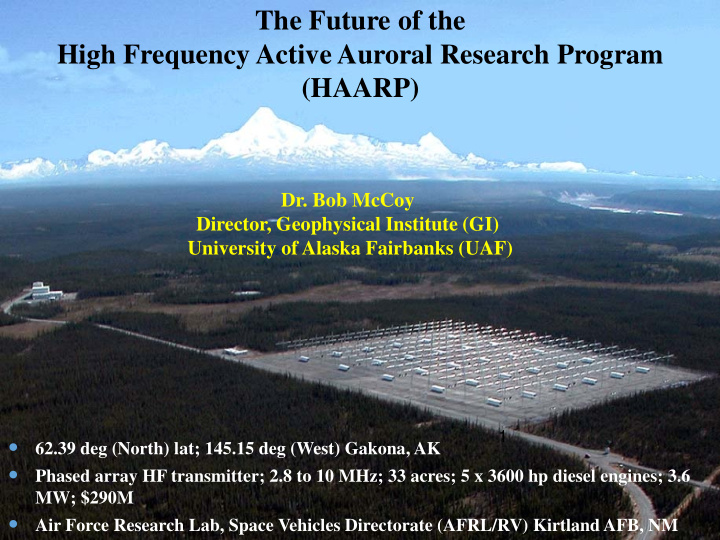



The Future of the High Frequency Active Auroral Research Program (HAARP) Dr. Bob McCoy Director, Geophysical Institute (GI) University of Alaska Fairbanks (UAF) 1 62.39 deg (North) lat; 145.15 deg (West) Gakona, AK Phased array HF transmitter; 2.8 to 10 MHz; 33 acres; 5 x 3600 hp diesel engines; 3.6 MW; $290M Air Force Research Lab, Space Vehicles Directorate (AFRL/RV) Kirtland AFB, NM
2
3
HF Ionospheric Heating ELF, VLF Magnetic Field Lines Ionospheric Irregularities Ionosphere 90 – 2000 km HF Energy Submarine 2.8 – 10 MHz Communication 3.6 MW
HAARP Compared to EISCAT, Sura & Arecibo Electron Acceleration, Airglow & Stimulated Ionization Log scale Science Threshold 5
2013: Two National Research Council Studies Involving HAARP • 2013 Decadal Survey in Solar and Space Physics - Priority - Fully realize the potential of ionospheric modification techniques through collocation of modern heating facilities with a full complement of diagnostic instruments including incoherent scatter radars. This effort requires coordination between NSF and DOD agencies in planning and operation of existing and future ionospheric modification facilities. • Mar 2013 - Workshop: Opportunities for High-Power, High-Frequency Transmitters to Advance Ionospheric/Thermospheric Research NRC Workshops do not provide recommendations but - report contains 72 pages of HAARP science Themes: Geospace and space weather; Stimulated - emission and radiation belts; radio science, communications, and radar Strong recommendation to co-locate incoherent scatter radar - http://www.nap.edu/booksearch.php?booksearch=1&term=sale&record_id=18620 6
Van Allen Radiation Belts L-Shells NASA Van Allen Probes
New HAAARP Results Related to Radiation belt Remediation and VLF Propagation DMS P satellite data over HAARP During heat ing experiment s observe enhanced upward plasma flux and elect ron densit ies Chris Fallen et al., 2011 Recent results from DARPA campaigns at HAARP have demonstrated optimum • heating techniques to continuously maintain upward field-aligned plasma flux, density and electron temperature enhancements in the topside ionosphere (about 400-800km). Structures may act as field-aligned waveguides for ducting VLF waves to the • magnetosphere and possibly to the opposite hemisphere. VLF waves may be generated by HAARP itself or other ground-based transmitter. • HAARP can be used to optimize the continuous formation of VLF ducts, and also to • simultaneously generate VLF signals.
Radiation Belt Dynamics and Energetics 2007 ONR MURI Topic ORANGE TEAK KINGFISH CHECKMATE STARFISH 3.8 MT at 43 km 3.8 MT at 76.8 km __ MT at __ km __ MT at __ km 1.4 MT at 400 km
TacSat-4 COMMX TACSat4 Actively Working Pointed to with UHF Ground Downlink HAARP Receiver Modified F-Layer Ionosphere Region Courtesy Paul Bernhardt NRL High Power HF Strong VHF Scintillations HAARP Ground Receiver
HAARP 14 Mar 2013, 01:02 GMT 250 14 March 2013 01:30 to 04:00 GMT Natural km 200 Altitude Extended Artificial Ionization Artificial 150 with 5.8 MHz Twisted Beam Plasma Frequency MHz 2 Minutes 100 Courtesy Paul Bernhardt 0 2 4 6 8 NRL HAARP 14 Mar 2013, 02:30 GMT HAARP 14 Mar 2013, 01:30 GMT HAARP 14 Mar 2013, 01:56 GMT 250 250 250 km km km 200 200 200 Altitude Altitude Altitude 150 150 150 Plasma Frequency MHz Plasma Frequency MHz Plasma Frequency MHz 1 ½ Hour ½ Hour 1 Hour 100 100 100 0 2 4 6 8 0 2 4 6 8 0 2 4 6 8 HAARP 14 Mar 2013, 03:30 GMT HAARP 14 Mar 2013, 04:05 GMT HAARP 14 Mar 2013, 03:00 GMT 250 250 250 km km km 200 200 200 Altitude Altitude Altitude 150 150 150 Plasma Frequency MHz Plasma Frequency MHz Plasma Frequency MHz 3 Hours 2 ½ Hour 2 Hours 100 100 100 0 2 4 6 8 0 2 4 6 8 0 2 4 6 8
Over the Horizon Radar Experiments 8 MHz; Covers range of ~1100 km Offset of transmitter and receiver to ~1800 km from radar location; 2000 km range translates to about 80° latitude Bill Bristow UAF/ GI
Ionospheric Diagnostic Instruments at HAARP • All sky Riometer • Imaging riometer 8 X 8 Array • Fluxgate Magnetometer • Induction Magnetometer • Digisonde • Optics All-sky imager Telescopic imager Photometers 14 ft Optical Dome • Tomography Chain (Cordova -> Kaktovik) • VHF Radar (139 MHz) • Modular UHF Ionospheric Radar (MUIR) • Ionospheric Scintillation Receivers SATSIN (offsite) GPS-NOVATEL Total Electron Content • Radio Background Receivers Broadband ELF / VLF Receiver network. SEE Receiver string. HF to UHF Spectrum Monitor • HF 2-30 MHz High Angle Receiving Antenna • Scanning Doppler Interferometer (SDI)
NSF Advanced Modular Incoherent Scatter RADAR (AMSIR) Poker AMISR – (PFISR) located outside Fairbanks at the Poker Flat Research Range for auroral studies & NASA sounding rocket launches
HAARP S tatus May 2015 • Owned by AFRL Space Vehicles Directorate (AFRL/RV) • Currently in cold storage ( Could be brought on-line in a few weeks ) • UA working with AFRL/RV to create a CRADA (2 years duration) Allow access to HAARP & restore scientific diagnostics to HAARP - Plans to transfer equipment, facilities & land to UAF - UAF-GI Activities: • Building Business Plan to operate HAARP • Reduce costs (use existing GI scientists & staff) • Identifying customers (DOE NNSA, DARPA, NSF, NASA, AFOSR, ONR/NRL, • USNORTHCOM, International) Explore new options for over the horizon radar for maritime awareness • Using HAARP to test space-to-ground communications – create scintillation •
Thank you, Questions? Photo Credit: Steve Estes 5/16/2012
Recommend
More recommend